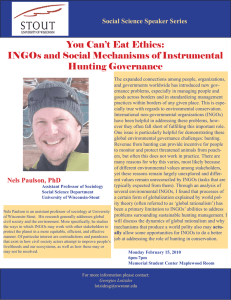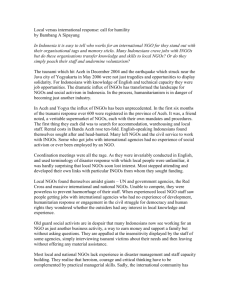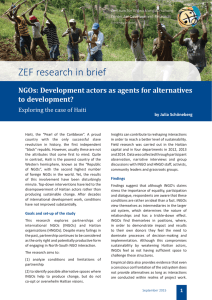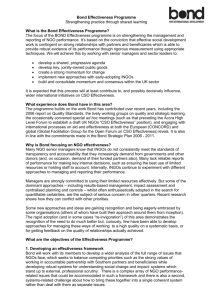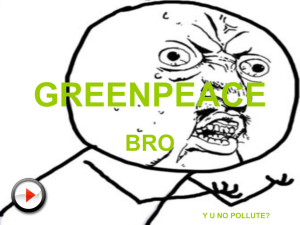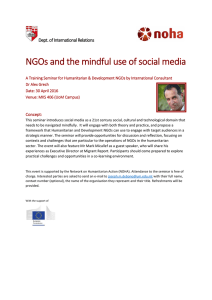IA Lecture 2 Pang Eng
advertisement
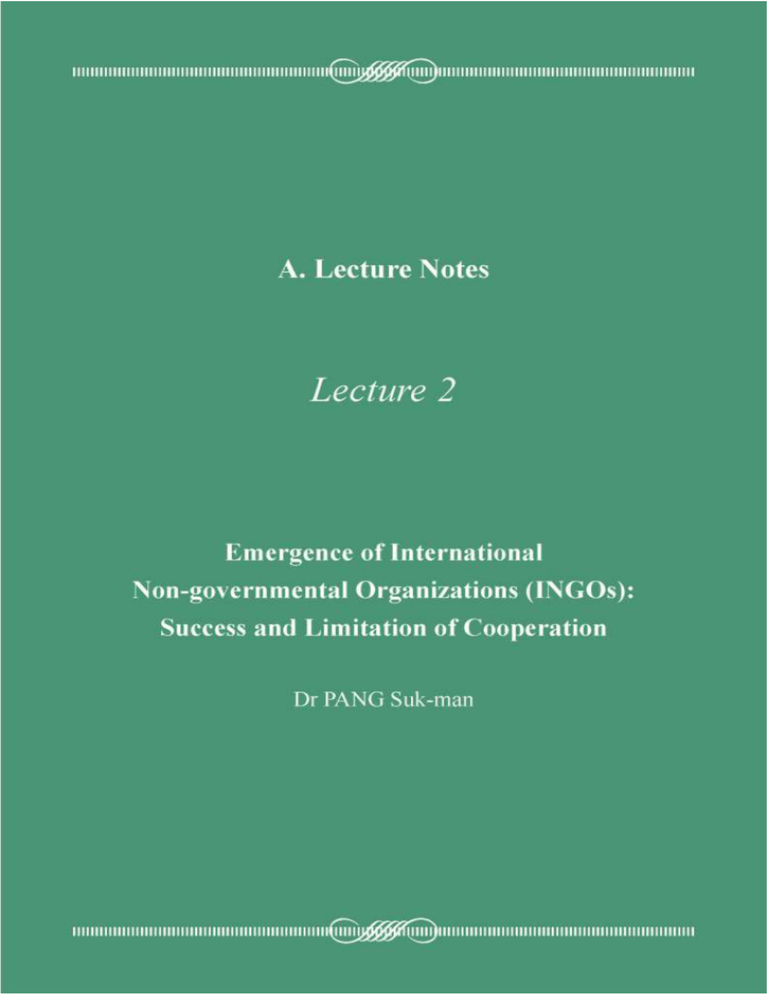
I KNOWLEDGE ENRICHMENT ││││││││││││││││││││││││││││││││││││││││││││││││││││││││││││││││││││││││││││││││││││││││││││││││││││││││││││││││││││││││││││││││││ Lecture 2 Emergence of International Non-governmental Organizations (INGOs): Success and Limitation of Cooperation Dr PANG Suk-man ││││││││││││││││││││││││││││││││││││││││││││││││││││││││││││││││││││││││││││││││││││││││││││││││││││││││││││││││││││││││││││││││││ 1. The concept of Non-governmental Organizations (NGOs) 1.1 Definition Western studies in the philosophy, goals, actions, function, scale and structure of Non-governmental Organizations (NGOs) throughout the years have been of great depth and prominence. Besides, in the mainland of China a global perspective is adopted to examine the development, features, function and influence of International Non-governmental Organizations (INGOs). Article 71 of Chapter 10 in the 1945 United Nations Charter provided for the emergence of non-governmental organisations - ‘The Economic and Social Council may make suitable arrangements for consultation with non-governmental organizations which are concerned with matters within its competence.’ The Economic and Social Council (ECOSOC) defined NGOs as: 1) non-governmental, as stated in the Resolution 28 of 1950: ‘Any international organization which is not established by intergovernmental agreement shall be considered as a non-governmental organization for the purpose of these arrangements;’ 2) independent, as seen in Resolution 1296 (XLIV) of 1968: ‘...including organizations which accept members designated by government authorities, provided that such membership does not interfere with the free expression of views of the organizations.’ In a press release, the United Nations offered the following in identifying non-governmental organizations: ‘A non-governmental organization (NGO) is a not-for-profit, voluntary citizens' group, which is organized on a local, national or international level to address issues in support of the public good. Task-oriented and made up of people with common interests, NGOs perform a variety of services and humanitarian functions, bring citizens' concerns to governments, monitor policy and programme implementation, and encourage participation of civil society stakeholders at the community level. They provide analysis and expertise, serve as early warning mechanisms, and help monitor and implement international agreements. Some are organized around specific issues, such as human rights, the environment or health.’ The defining features and reasons behind the rise of NGOs shall be addressed hereafter, followed 27 by the analysis of the effectiveness of NGOs through individual case studies on Greenpeace, Médecins Sans Frontières (MSF) and Lions Club International (LCI) by focusing on their rise, development and limitations at cooperation. ││││││││││││││││││││││││││││││││││││││││││││││││││││││││││││││││││││││││││││││││││││││││││││││││││││││││││││││││││││││││││││││││││ 2. The features of NGOs 2.1 The seven features According to Zhuo Kuan and Zhang Zhigang, NGOs are basically characterized by seven major features including unofficial, voluntary, structured, privately-owned, non-profit making, communal and autonomous: 1. They are unofficial organizations which are independent from political governments; 2. Members join voluntarily and their time and money contributions are offered under free will; 3. Systems of operation are highly structured with clearly-defined goals and sustainable activities; 4. Being privately-owned, they separate from governments in their systems of operation and are financially independent; 5. They are non profit-making and all gains belong to society 6. Funding is gained through membership dues, public donations or government funding, making them communal; 7. NGOs are autonomous as they are relatively independent of government 2.2 The features of INGOs In terms of INGOs, Western scholars have emphasized their multi-national nature which allows for the participation of other similar social organisations. INGOs are known to set goals that encompass national borders and they are non- profit making bodies. Public International Law recognizes INGOs as privately-established institutions that organize non-profit, non-state multi-national activities for the global society. In other words, INGOs are non-governmental organisations that encompass members from different nationalities, are non-profit and have an independent administrative body. Studies from the mainland of China have further identified INGOs as possessing branches and holding activities in the borders of at least two or more countries and having the following features of being structured, communal, non-profit, autonomous, voluntary, non-religious, non-political, charitable, legitimate and international. Apart from extending their goals and activities beyond two countries, members of such organizations should come from different countries, and both the source and usage of funds should be international in nature. Therefore, an INGO can be summed up as an organization that operates across borders, takes part in charitable activities and has the features of non-governmental organizations. 28 In addition to the numerous dynamic advantages INGOs possess that permit them to be more actively involved in international affairs, developments in networking capabilities, organizational structure and activity genre are also networking benefits INGOs enjoy. At the operational level, INGOs are involved in activities that include disaster relief, emergency relief, educational activities and assisting developing countries in their projects through the use of its vast resources and established relief work. Organisations such as World Vision, MSF, World Wildlife Fund and Oxfam actively participate in the affairs of each country. The promotion of INGOs’ goals and activities is commonly achieved by delivering messages to national governments, multi-national corporations and the global mass. INGOs possess clear-cut policy objectives and agenda and their objectives become more concrete through persuasion and engagement. Moreover, INGOs often aim at changing existing policies and they appear radical at times. The activities planned by the Greenpeace is a good example. ││││││││││││││││││││││││││││││││││││││││││││││││││││││││││││││││││││││││││││││││││││││││││││││││││││││││││││││││││││││││││││││││││ 3. The rise of INGOs 3.1 The reasons behind the rise of INGOs The major reasons for the rise of INGOs include the end of the Cold War, the Communication Revolution, the widespread use of the Internet, economic globalization and their own favourable condition. Firstly, the ideological confrontation between superpowers in world politics terminated with the end of the Cold War. Conflicts among nations, together with disputes over religions and territories gradually occurred. Regional and civil wars broke out one after another. INGOs took up the role as mediators. Secondly, the Communication Revolution and technological advancement, widespread use of Internet in the world have allowed the organisations to develop a comprehensive data bank that could provide new structural forms and activity genres. Thirdly, values in freedom, democracy, human rights and peace through the development of a global economy have become universal. The INGOs especially advocate their support to humanity. The internationalization of domestic issues including eco-environmental problems, resource shortages, poverty, crime, drugs and population issues simultaneously calls for multi-national cooperation to solve these problems. Fourthly, INGOs’ own favourable condition including their system of operations, structure and activity genre are so flexible that they can react to problems and make decisions rapidly. A number of large INGOs have established branches in different parts of the world which facilitate staff communication. They can offer assistance to the needy through direct contact with the local NGOs or reach those in need directly. As members of such organizations are usually intellectuals, who have the advantage for being knowledgeable 29 people, they always propose new ideas and concepts with strong persuasive power. In addition, some INGOs are known for their technical expertise and they become partners of the United Nations. INGOs are also known for their moral advantage and their contributions to charity, public welfare and the formation of an altruistic society. INGOs reflect the common interest of the international community, they are recognized as ‘the conscience of the world.’ ││││││││││││││││││││││││││││││││││││││││││││││││││││││││││││││││││││││││││││││││││││││││││││││││││││││││││││││││││││││││││││││││││ 4. The development of INGOs INGOs play an active role in the international society through charitable activities, environmental conservation and the provision of medical aid. The INGOs are unique in their origin and development. 4.1 Helping the poor in the international community Firstly, the active participation of INGOs in assisting the poor is as follows: 1. Material alleviation is provided in early relief work in response to disasters; 2. Through knowledge assistance, a number of projects and training programs are offered to improve technical skills of local people, develop education and subsidize the building of schools; 3. Ability-raising is encouraged as the poor are given opportunities and conditions at realizing potentialities; offering low-interest loans is an example; 4. By system transformation, INGOs work out policies that fit the needs of impoverished areas or population-stricken territories. One specific feature that INGOs possess in poverty alleviation is that they take up governmental projects in assisting the needy, ensure close interaction with farmers for better understanding of their situations and work with great efforts to disperse new knowledge and technical skills for raising general ability to eliminate poverty. The effect of poverty alleviation is obvious. Secondly, the mode of assistance for the poor can be classified into direct and indirect ways. For example, indirect assistance is given to African countries, regional governments or governmental organizations; to local non-governmental organizations there and assistance is also given through different branches of NGOs. Direct assistance, on the other hand, is provided through the distribution of food, the provision of medical and health services or security guarantees depending on the particular needs of differing communities. INGOs have organized small-scale self-development training programs; in other occasions, international, national and local systems and policies have been bettered and improved in order to eliminate the fundamental evils that have led to poverty. 30 INGOs’ activities to alleviate African poverty include the following: 1. Survival aid: directly provides for the clothing, food, shelter and transport of African communities, particularly concentrated in war-stricken areas and those affected by natural disasters such as the Darfur region of Sudan, the north-eastern part of the Democratic Republic of Congo and northern Uganda; and the refugee issue caused by conflicts; 2. Technical aid: educates people in backward regions of Africa with new technical skills and knowledge in farming, raising livestock and processing industry, and starting non-dominant industries in the production of clothing, bamboo products as well as pottery for the purpose of increasing the income of local people; 3. Financial aid: encourages African farmers to make good use of their agricultural and pastoral produce in exchange for loans and for the investment of such loans in gardening, poultry farming, soap making and food processing whilst simultaneously assisting them in looking for potential markets. Similarly, INGOs also offer credit loan schemes in hope of improving the living conditions of local people; 4. Educational assistance: provides volunteers or funding to ensure basic education for children. At times, learning materials are delivered by volunteers to remote areas where they work as teachers. As an example, Oxfam has demonstrated effective assistance in ensuring education for Tanzanian children; 5. Infrastructure assistance: hires victims of disasters to maintain water safety through the cleaning up of shrubs and siltation, building toilets and carrying out drilling works; half of the income derived is subsequently used to purchase food stuff for the local communities; 6. Legal assistance: offers help in proceedings and litigation procedures, further protecting the legitimate rights and interests of poverty-stricken commoners and strengthening their legal awareness for the purpose of enlightening local people with legal information; 7. Environmental protection: assists the African government and people in improving the environment, securing a clean source of water and eliminating desertification. For sustainable development, poverty alleviation cannot be separated from environmental protection. INGOs have indirectly assisted various African governments in setting policies to address the needs of impoverished areas. Through the acts of initiating, persuading, integrating and cooperating, INGOs have prompted local governments to change their policies in light of creating a more favorable environment for carrying our activities of alleviating poverty. Successful cases can be found in Kenya, Uganda and Tanzania. Moreover, a number of African governments have undergone administrative reform in recent years for enhancing both a sense of staff responsibility and the efficiency of government offices, with emphasis on the importance of learning from NGO’s work experience and administrative management. 31 4.2 Environmental conservation INGOs play an active role in environmental conservation. Article 4 of the United Nations Framework Convention on Climate Change emphasized that all parties should take into account their ‘common but differentiated responsibilities’ in considering specific national and regional development priorities, objectives and circumstances for the education, training and raising of public awareness with regard to climate change-related issues. Article 7 of the Convention allows NGOs to participate as observers in meetings and this marks the beginning of encouraging NGOs to participate in commencement of treaties on climate change. Simultaneously activities have been held by NGOs to raise the awareness of the international community on the problems of climate change. 533 NGOs took part in the second conference for the United Nations Framework on Climate Change Convention. By the end of 2009, more than 1,300 NGOs joined the Copenhagen Summit, of which 345 NGOs were officiated as observers. In addition, NGOs have contributed to the formulation, development and implementation of international law. They have remarkable achievements in the area of climate change and play significant roles in the signing of the Protocol to the Antarctic Treaty on Environmental Protection and also in participating at the International Indigenous People’s Forum on Climate Change and the formation of the International Coastal and Ocean Organization. 4.3 Sanitary and Medical work As early as the 18th century, public health activities attempting to improve the cleanliness of American cities have already been organized by non-governmental women’s organizations. The Rockefeller Foundation and the Anti-Tuberculosis League inside the League of Nations joined hands to fight the plague and several infectious diseases during the 19th century, bringing a number of other public health issues to light. The INGOs actively participate in sanitary and medical work including cure of infectious diseases, prevention of chronic non-contagious diseases, children and women’s health, medical research, personnel training, improving public health facilities and ensuring the safety of drinking water. The Joint United Nations Programme on HIV/AIDS (UNAIDS) has worked with NGOs in the cure of infectious disesases. Since the emergence of AIDS, tens of thousands of NGOs, together with the UNAIDS, have joint efforts in organizing more than one million events and programs, garnerning more than 200 billion US dollars in funds,. for example, the International AIDS Society, the Family Health International (FHI, U.S.A.), the British FHI, the Bill and Melinda Gates Foundation, the Global Network of People Living with HIV, the International Community of Women with HIV/AIDS, the International Council of AIDS Service Organizations, the International AIDS Vaccine Initiative and the Global Business Coalition on HIV/AIDS. INGOs have further participated in the prevention and control of SARS, hepatitis, malaria, polio, measles, dengue fever, anthrax, tuberculosis, meningitis, scarlet fever, schistosomiasis, Ebola hemorrhagic fever, avian flu and H1N1, as well as influenza and other infectious diseases. 32 Examples of INGOs involved in the prevention and treatment of chronic non-contagious diseases include the International Diabetes Foundation (IDF), the Union for International Cancer Control (UICC), the World Heart Federation (WHF), anti-tobacco NGOs, Global Alliance against Chronic Respiratory Diseases, the International Hospital Federation (IHF) and the International Osteoporosis Foundation (IOF). The International Red Cross has been prominent in the promotion of children’s and women’s health. The Chinese Red Cross Foundation has been involved in a number of meaningful projects: the Little Angels Fund of China Red Cross Society has done much in helping children with leukemia; the Smile Angel Foundation has worked with assisting children with cleft lips; the Angel Sunshine Heart has saved children with heart diseases; the Love Angel is an organization providing aid to children with cerebral palsy; the Angel’s Echo was set up for children with hearing defects; the Warm China project aims at helping the poor who are diagnosed with tumors and the Running Angel Fund assists children with lower limb deformities. Similarly, other INGOs that are worth noting include the United Nation’s Children Fund (UNICEF), Save the Children International, the Bill and Melinda Gates Foundation, the Ford Foundation, the Alliance for Smiles, the United Nations Development Fund for Women, Project Hope, the National Sanitation Foundation International (NSF), Flagship Global Health, Renewal Foundation, AmeriCares, the Avon Foundation for Women, the Medtronic Foundation, the Baxter International Foundation and the Abbott fund. With regards to medical research and personnel training, the Bill and Melinda Gates Foundation, aiming to better global health, has funded research studies on AIDS, malaria, tuberculosis and cancer in search for more effective treatment and new medical technology. The British Wellcome Trust has also funded the study of human genetics, placing much focus on cases of measles and diabetes in developing countries. As INGOs stress on the importance of training medical professionals, there has been funding persistently set aside to send medical technicians abroad for further studies, as well as to encourage studies on clinical technology and research, or sponsor doctors to have treatment for patients in needy areas. As for bettering public health facilities and securing safe drinking water, 16 individual NGOs have worked with the Asian Development Bank to provide public health services. Primary health and sanitary services have also been offered to low-income persons. For example, assistance has been given to the Cambodian government in disease prevention, family planning, prenatal care, nutrition guarantees and in dealing with other common diseases. 4.4 Greenpeace Being the largest and most influential international environmental organization, Greenpeace is also known as a significant pacifist organization. It emerged in pursuit of a nuclear-free world through advocating anti-nuclear and anti-war ideas, fighting for armaments reduction, opposing nuclear tests, nuclear arms race and wars. Notably, Greenpeace became known after a group of small activists set sail to the Amchitka Island off Alaska to stop the American nuclear weapons test. Subsequently, the island became a nature reserve. 33 Greenpeace emerged in 1985. During that year, French agents attempted to stop Greenpeace members from traveling to France for a demonstration against the nuclear test in the South Pacific. Their ship “Rainbow Warrior” was bombed in the port of Auckland in New Zealand. The French government later paid a compensation of USD 3.1 million after the incident was publicized. As the event caused a sensation, Greenpeace received much publicity. At present, its branch in Hong Kong has become a part of Greenpeace East Asia which is active in the mainland of China, Hong Kong and Taiwan. The major activities of Greenpeace are to prevent any sort of harm that could come to the environment that human survival depends on and bring about harmony between men and nature. The organization also attempts to stop toxic chemicals from polluting the environment, condemn the use of nuclear weapons and nuclear energy in order to eliminate nuclear threat in the world. Climatic changes, global warming, problems concerning the Ozone layer, protecting the marine environment, primary forests and opposing genetically modified (GM) foods are also part of Greenpeace’s agenda. Greenpeace is famous for its ‘non-violent direct action’. In terms of direct action, the protests organized by Greenpeace members are always thrilling, of individual heroism, dramatic and bizarre. In some occasions, members chain themselves to trees in order to prevent them from being chopped down; other examples include crashing their rubber boats with whaling ships in the Pacific or blocking the way of the big navigation ships which carry nuclear wastes. The networking of Greenpeace has a wide coverage. As early as 1985, the Internet had already been utilized for organizing events. In 1994, its website (www.greenpeace.org) was established. There are also webpages for its headquarter and respective branches, therefore it is rich in web resources. Moreover, such webpages are always target-oriented: for instance, the network on food has become an important basis for the organization’s fight against Genetically modified foods (GM foods). Greenpeace utilizes the Internet to promote its activities by using lots of pictures and images with great sensational effect to capture readers’ attention. Through the development of technology in environmental conservation and promoting environmentally-friendly products, Greenpeace tries to reduce harm to the environment. Ozone-friendly refrigeration technology, widely-used by various European manufacturers, for example, was invented by the organization. In face of global warming, Greenpeace has attempted to persuade oil companies in developing alternative energy, exerting much effort in promoting the use of solar and wind energy, both of which are known to be non-pollutants. In terms of international treaties, Greenpeace has also played a part. The United Nations Environment Programme (UNEP) opened dialogue on the threats of Persistent Organic Pollutants (POPs) in 1996. Greenpeace was influential in the process of drawing the 26 international protocols. These multi-national 34 agreements include the prohibition of the export of toxic substances to developing countries, commercial whaling, and the use of gigantic nets in fishing, the establishment of a whale sanctuary in the South Pacific, the prohibition of mining in Antarctica in the next 50 years, prohibition of dumping radioactive elements, industrial wastes and oil extraction equipment in seas and oceans, as well as a comprehensive ban on nuclear test. 4.5 Médecins Sans Frontières (MSF) Médecins Sans Frontières, also known as ‘Doctors Without Borders’ is an INGO that specializes in medical assistance. As a Nobel Peace Prize laureate (1999), the MSF has established international status in the field of medical care. In addition, the organization advocates for the development of humanitarian values. The origin of the MSF can be traced back to 1968. During the Nigerian Civil War, a number of French doctors volunteered to take up humanitarian work. To them, humanitarian relief work was of high importance. The doctors were discontented and disappointed with the International Red Cross which had serious limitations in terms of emergency relief. Gradually, the conventional perception of International Red Cross was replaced by a belief that people’s right to medical care outweighs respect for national borders. Therefore, it was emphasized that humanitarian aid ought not to be limited by national borders. If atrocities involving the violation of human rights were encountered during the execution of humanitarian aid, humanitarian workers are also expected to stand up for the victims. The years between 1971 and 1975 were the initial stages of MSF’s establishment. It was formed by a group of doctors in 1971. Notably, only a few dozen doctors could be sent for humanitarian missions annually at this stage and the organization was active solely in Nicaragua and Honduras to carry out its duties. From 1976-1979, MSF entered its commencing stage. In 1976 volunteers were sent to Lebanon where civil war broke out. Their acts of bravery and relief work were reported by media in the United States which eventually attracted public attention outside France. When the UN Refugee Agency tried to tackle the refugee problem, it had to face the challenges of shortage in funding and manpower. MSF began to gain prominence because of its advantageous position. The oversupply of French doctors allowed MSF to recruit an enormous haul of volunteers to assist in refugee camps. MSF took part in rescuing Angolan refugees in Zaire from 1976-1979, and aided Somali victims in Djibouti, Sahawari refugees in Algeria and Eritrea, as well as Vietnamese, Cambodian and Laos refugees in Thailand. The developing stage of MSF was between 1979 and 1990. During this period, a dramatic increase in the number of refugees worldwide allowed MSF to expand its services by increasing the number of doctors and nurses by 800 people each year. As the volunteers served in war-stricken areas in Central America, South Africa, Middle East and Southeast Asia, the MSF commenced its role in the international arena, establishing support sections in Belgium and Switzerland in 1981, in Holland during 1983 and in Spain and Luxembourg in 1985. In 1990, MSF set up its International Council and International Secretariat, both of which assisted in 35 coordinating of the various support sections. Recognized as the world’s largest independent humanitarian relief organization, MSF entered a stage of maturity after 1991. During this period, the organization concentrated on addressing the humanitarian needs of western European countries such as Belgium, France and Spain and provided service for drug abusers, AIDS patients, immigrants and asylum-seekers. The headquarters of MSF was established in Belgium, with more than a dozen support sections in charge of recruiting volunteers, raising funds and promoting the organization. Moreover, MSF has set up 5 operational centers in Amsterdam, Brussels, Geneva, Barcelona and Paris, which manage and monitor the organization’s worldwide projects, further making operational decisions on MSF’s strategies in humanitarian assistance. Medical relief activities under MSF can be classified into two types, namely emergency relief and long-term relief. In terms of emergency relief, MSF provides relief to refugees of wars and victims of natural disasters. Serving in the front line, the organization offers basic health care, nutrition services, medicine distribution, vaccination assistance, provision of clean water and sanitation facilities to control the spread of contagious diseases. Psychological therapies are also offered. Besides, MSF’s rescue missions are known for their reliable speed and great efficiency. In face of a humanitarian crisis, the organization takes the initiative to send medical and logistic assistance to affected areas for on-site inspection to evaluate the nature of aid that would be required, the ability of local governments in dealing with the crisis, as well as the resources, transport and logistics that would be needed. MSF cargo planes carrying staff and equipment normally arrive in affected areas within 48 hours. To attain the highest efficiency, MSF has 4 other back up centers that store emergency supplies in Europe, East Africa, Central America and East Asia. In terms of long-term relief, MSF offers assistance in countries that either lack medical facilities or health care. MSF works closely with local health authorities in rebuilding hospitals and epidemic prevention stations, promoting projects in health and nutrition and training local medical staff. For example, MSF has helped establish control centers for malaria and HIV in Cambodia .. The activities of MSF have placed much focus on the importance of human rights to the use of medical care and resource aids. Notably, MSF stands by the principles of ‘impartiality’ and ‘neutrality’ in order to protect its humanitarian volunteers. 4.6 The Lions Club International (LCI) The Lions Club International was first established in 1917 by Melvin Jones who was an insurance agent in America. He wished to bring the commercial center of Chicago and other independent clubs together for raising concerns beyond commerce. His aim was to establish a national organization to serve both the business sector and society, and to work for social unity as well. On June 7, the name Lions Club was adopted by representatives from 22 clubs in America and endorsed its constitution. LIONS refers to Liberty, Intelligence, Our, Nation’s, Safety. Since its emergence in the United States, the organization has established various branches all around the world, gradually expanding in size and scale. 36 The LCI’s activities can be characterized by the term ‘non-political’ where it was agreed that ‘partisan politics and sectarian religion shall not be debated by club members.’ The organization works for promoting understanding and friendship among people and sets its goal in securing world peace. Operating in the form of a ‘club,’ the LCI encourages exchange and communication amongst its members, particularly through their annual international convention. A considerable number of the organization’s members are social elites and prominent figures in commerce and industry. They come from a range of occupations such as entrepreneurs, managers, doctors, lawyers, government officials, teachers and community enthusiasts. LCI also involves the participation of political leaders like Jimmy Carter, the ex-president of the U.S.A. Based on the motto of LCI which is ‘We Serve,’ focal programs of the Lions Club include community service, aiding disaster relief, poverty alleviation, medical care, social welfare, education, preventing blindness, youth programs, environmental protection and humanitarian relief projects. LCI has actively participated in the “Blindness Prevention and Treatment” event in China, and has come up with the program known as ‘Sight First.’ On the other hand, the ‘Lion Cubs’ stages various programs for the youth, holding international camps and youth exchanges and funding academic scholarships. In addition, the Lion Cubs program serves to prevent youngsters from substance and alcohol abuse, and provide them with job training where needed. As a global organization for charity, LCI is the first INGO to be established in the mainland of China. The creation of the Chinese branch marked the commencement of China’s participation in INGO projects, simultaneously signifying a crucial transformation in China’s relation with INGOs. On 2 April 2002, the Shenzhen Lions Club was successfully founded in China. On 8 April, the Shenzhen Lions Club was allowed entry into LCI, marking the establishment of the first Lions Club branch in China under International District 303 of Hong Kong and Macao. Between 1997 and 2002, the Shenzhen Lion Club collaborated with the Ministry of Health and the China Disabled Persons’ Federation in creating the ‘Sight First China Action.’ As of August 2002, LCI has supported 1.2 million cataract surgeries through a grant of 15 million US dollars. Moreover, surgical eye units were set up in 104 county-level hospitals where 11,000 medical staff members were trained; a national network of eye-disease prevention database was further established. It is honoured as “the escort who sows the brightness”. ││││││││││││││││││││││││││││││││││││││││││││││││││││││││││││││││││││││││││││││││││││││││││││││││││││││││││││││││││││││││││││││││││ 5. The limitation of cooperation Firstly, INGOs are subject to the control of local governments during their collaboration in the process of alleviating poverty. Although Article 4 of the United Nations Framework on Climate Change Convention encourages participation in a public capacity including the NGOs, participation is confined to the promotion and cooperation ‘in education, training and public awareness to climate change.’ There is no mandatory binding international law. Thus, even though organizations like Greenpeace are dedicated to monitoring the 37 execution of the treaty of climate change, there is no legal agency that allows their formal participation. As NGOs are pushed outside the system, they have no influence in the conclusion and implementation of treaties. The INGOs has a number of limitations. Humanitarian aid cannot stop the outbreak and persistence of war and neither can it exert political force. The INGOs enjoy very limited rights in participating the affairs of the United Nations. Moreover, geographical difference implies that INGO sections in developed countries tend to be better equipped, are of a larger scale, and better funded, allowing them more say and influence when making decisions in the United Nations. ││││││││││││││││││││││││││││││││││││││││││││││││││││││││││││││││││││││││││││││││││││││││││││││││││││││││││││││││││││││││││││││││││ 6. Conclusion The rise of NGOs since the 1980s has been a global phenomenon. NGOs have diversified structures, goals and slogans and are active in international conventions, speeches and demonstrations. They have impact on world economy and peaceful development, especially within the fields of medicine, culture, education, humanitarianism and environment. According to the Yearbook of International Organizations (2004-2005), the number of NGOs in the world has come up to more than several millions of which more than 50,000 are INGOs, encompassing over 200 different nations and regions. In view of their size and power, NGOs are certainly worthy of our attention. References: English References: 38 1. Betsill, Michele M. and Corell, Elisabeth, eds. NGO Diplomacy: The Influence of Nongovernmental Organizations in International Environmental Negotiations. Cambridge, Mass.: MIT Press, 2008. 2. Doh, Jonathan P. and Teegen, Hildy, eds. Globalization and NGOs: Transforming Business, Government, and Society. Westport, Conn.: Praeger, 2003. 3. Lewis, David and Kanji, Nazneen. Non-governmental Organizations and Development. London; New York: Routledge, 2009. 4. Lindenberg, Marc and Bryant, Coralie. Going Global: Transforming Relief and Development NGOs. Bloomfield, CT: Kumarian Press, 2001. 5. Willetts, Peter, ed. ‘The Conscience of the World’: The Influence of Non-governmental Organisations in the UN System. Washington, D.C.: Brookings Institution, 1996. 6. Yaziji, Michael and Doh, Jonathan. NGOs and Corporations: Conflict and Collaboration. Cambridge, UK; New York: Cambridge University Press, 2009. Related websites: 1. CARE International http://www.care.org 2. Development Economics Vice Presidency (DEC) http://www.worldbank.org 3. Friends of the Earth International, FOEI http://www.foei.org 4. Greenpeace International http://www.greenpeace.org 5. Human Development Network (HDN) http://www.worldbank.org 6. Lions Clubs International http://www.lionsclubs.org 7. Médecins Sans Frontières (MSF) http://www.msf.org.hk/index.php?lang=tc 8. ORBIS International http://www.orbis.org 9. Oxfam http://www.oxfam.org 10. Poverty Reduction and Economic Management Network (PREM Network) http://www.worldbank.org 11. The Salvation Army International http://www.salvationarmy.org 12. The World Bank http://www.worldbank.org 39 13. The World Bank Institute (WBI) http://wbi.worldbank.org/wbi/ 14. The World Bank Treasury http://treasury.worldbank.org 15. World Vision http://www.worldvision.org 16. World Wide Fund for Nature (WWF) http://www.wwf.org Chinese references: 40 1. Ann C. Hudock 原著,江明彥審訂: 《非政府組織》(台北:智勝文化事業有限公司,2003)。 2. 王杰、張海濱著,張志洲主編: 《全球治理中的國際非政府組織》(北京:北京大學出版社,2004)。 3. 田玉榮主編: 《非政府組織與社區發展非政府組織和社區發展論壇》(北京:社會科學文獻出版社, 2008)。 4. 朱建民:《國際組織》(台北:正中,1962)。 5. 行政院研究發展考核委員會編: 《我國與國際非政府組織發展關係之研究》(台北:編者,1993)。 6. 康曉光等著: 《NGO 與政府合作策略》(北京:社會科學文獻出版社,2010)。 7. 劉鴻武、沉蓓莉主編: 《非洲非政府組織與中非關係》(北京:世界知識出版社,2009)。 8. 蔡明殿、王淑英編著: 《與世界衛生組織有正式工作關係的非政府組織:WHO 工作守冊》(高雄: 春暉出版社,2003)。 Chinese Journals: 1. 尹瑋: 〈淺析國際非政府組織在國際法中的地位〉 , 《安徽農業大學學報》16 卷 4 期(2007) ,頁 79-83。 2. 邱偉、劉力 : 〈透視日益走近中國的國際非政府組織〉,《學習月刊》241 期(2005),頁 46-47。 3. 李湘雲、王濤: 〈論國際非政府組織在非洲的扶貧模式及成效〉 , 《思想戰線》37 卷 5 期(2011),頁 147-148。 4. 卓寬、張志剛: 〈國際非政府組織參與社會扶貧的文獻研究〉 , 《中國-東盟博覽》71 期(2011),頁 20-21,49。 5. 吳惠敏: 〈19 世紀中後期-20 世紀初國際非政府組織探析〉 , 《雲南師範大學學報》40 卷 1 期 (2008) , 頁 53-57。 6. 苗艷麗:〈冷戰後國際非政府組織崛起的原因〉, 《長治學院學報》22 卷 4 期(2005),頁 3-5。 7. 孫茹:〈國際獅子會〉 , 《國際資料信息》11 期(2002),頁 37-39。 8. 孫茹:〈無國界醫生組織〉 , 《國際資料信息》10 期(2002),頁 27-31。 9. 孫茹:〈綠色和平組織〉 , 《國際資料信息》8 期(2002),頁 34-39。 10. 郝雅燁子: 〈論氣候變化條約體系國際非政府組織的地位〉 , 《太原理工大學學報》30 卷 3 期(2011) , 頁 20-24。 11. 畢瑩: 〈從國際法視角看國際非政府組織在華法律地位〉 , 《社團管理研究》6 期(2012) ,頁 35-37。 12. 陳寶文:〈冷戰後國際非政府組織的發展背景及崛起原因〉,《重慶科技學院學報》1 期(2009), 頁 51-52。 13. 張彩霞:〈國際非政府組織在全球衛生治理中的作用與職能〉,《經濟研究導刊》34 期(2011),頁 245-247。 14. 張學良: 〈論全球化進程與國際非政府組織的地位和作用〉 , 《法制與社會》4 期(2012) ,頁 129-130。 15. 趙曉芳:〈非政府組織的界定及其參與扶貧的戰略分析〉,《蘭州學刊》4 期(2010),頁 77-80。 16. 熊薜芬:〈聯合國與國際非政府組織關係的演變及前景〉,《雞西大學學報》9 卷 6 期(2009),頁 44-45。 17. 劉穎:〈全球環境治理中的國際非政府組織:以綠色和平為例〉,《國際資料信息》8 期(2002), 頁 102-105。 41
